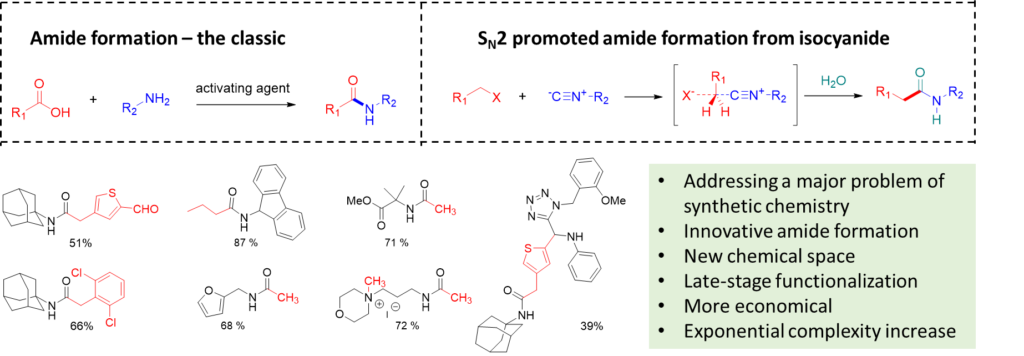Scientists introduce unprecedented and highly creative approach to amide synthesis
New possibilities for the design of new amides, substances ubiquitous in the world of organic compounds, have been proposed by scientists from the Czech Advanced Technology and Research Institute (CATRIN) and the Institute of Molecular and Translational Medicine of Palacký University in collaboration with colleagues from the University of Groningen, The Netherlands, and Jagiellonian University in Krakow. Thanks to a revolutionary method that uses the unique properties of isocyanides, they have overcome the existing boundaries of amide synthesis and opened up new possibilities in organic chemistry. The study was recently published in the prestigious journal Nature Communications.
Amides are found in peptides, proteins, drugs, and various functional materials. Traditionally, they are synthesized almost exclusively by coupling carboxylic acids and amines through ‘non-green, unsustainable’ routes. Now, however, scientists are offering a surprising and complementary method, added to chemists’ tool box. Based on 30 years of experience in isocyanide chemistry, world-renowned researcher Alexander Dömling used the power of isocyanides to create a novel three-component reaction.

“This reaction involves isocyanides, alkyl halides and water, leading to the rapid formation of very valuable amides. What makes this method truly remarkable is the scope and versatility it offers. We have demonstrated that it can be applied to a wide range of substrates, including alkyl halides with different leaving groups, various isocyanides and even complex heterocyclic structures. The possibilities are almost endless, allowing the synthesis of diverse and complex compounds that were previously considered challenging or impractical or were based on expensive or unavailable building blocks,” said Professor Dömling.
According to the authors, this innovative synthesis of amides is not only efficient, but also sustainable. It uses readily available and cost-effective starting materials, making it a practical choice for both academic research and industrial applications. “Scaling up the reaction to gram-scale production has already been successfully achieved, demonstrating its robustness and potential for large-scale synthesis,” said Pravin Patil, a co-author of the publication.
Furthermore, this method opens the door to late-stage functionalization of drug molecules, providing a valuable tool for pharmaceutical research and development. By repurposing alkyl halides, researchers can easily introduce new functionalities into existing drug candidates, potentially leading to the discovery of more effective and potent medications.
“This breakthrough is not just another scientific achievement—it’s a gateway to a world of possibilities in chemistry and beyond,” added Dömling. This leading scientist is now assembling an international team in Olomouc thanks to the ERA Chair ACCELERATOR project, which aims to contribute to sustainable chemistry and more efficient development of new drugs, nanomaterials or plant protection agents or biostimulants using miniaturization and automation.
Isocyanides are organic compounds with a functional group consisting of a nitrogen atom that is coupled to a carbon atom through a single bond and to another carbon through a triple bond. They are important functional groups in organic chemistry and have a wide range of applications in both laboratory environments and industry.

